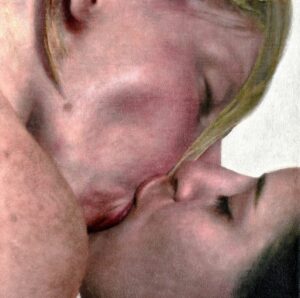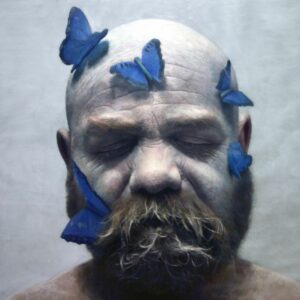< retour aux artistes
< volver a los artistas
< back to artists

Biographie
Biography
Biografía
Born in Madrid on December 28, 1973, Eloy Morales is a Spanish hyperrealist painter.
Initiated by his father, a passionate self-taught artist who dedicated his nights to drawing after his workdays, Eloy Morales began practicing his art from a very young age. The artist recounts that at the age of seven, he could spend weeks working on a single drawing.
Immersed in reading comic books and comics like “Conan the Barbarian,” the young boy tried to reproduce various combat scenes, particularly inspired by the works of John Buscema, in which he recognized a certain anatomical accuracy.
At the age of nine, he discovered oil painting: a particularly complex medium to master, revealing an early pursuit of technical skill.
Convinced that he had found his path, Eloy Morales never stopped sketching, watercoloring, and painting throughout his life. He graduated from the Fine Arts School of Madrid (Complutense University) in 1998, describing his years of study as a period of intense exploration. Curious about all forms of art and all masters, he observed and gradually built his own artistic identity.
One of his early portrait series, titled “El Nadador” (“The Swimmer”), depicts a swimmer in a red bathing cap, showcasing his commitment to working on chromatic contrasts and a meticulous quest for accuracy.
However, it was the creation of “David” in 2007, a large-format oil painting portraying his brother covered in shaving foam, that marked a turning point in his career. The brilliance of the thick, cottony substance gave him the idea for the series that would make him known to the general public. The collection “La pintura en my cabeza” or “Paint in my Head” was born.
The title plays with words to convey the subject of these paintings to the viewer: Eloy Morales speaks to us about his relationship with painting through self-portraits in which he stages himself, his face covered in paint. The artist describes this approach as a desire to express how he has internalized his practice over the course of his life and how it has affected him. Furthermore, the series seems to coincide with his personal evolution. The impastos become thicker, more fluid, or, on the contrary, more viscous, sometimes more colorful, like a metaphorical testimony of his experiences and feelings.
Eloy Morales, despite having achieved mastery, did not initially intend to become a hyperrealist painter or to be labeled as such. By initially seeking to explore all that he could offer, the artist played with the boundaries of figurative art. His technical mastery creates confusion for the viewer: Is it a photograph? Is it really a painting?
It is only by getting up close to the artwork that the mystery is solved: you can discern the brush strokes and even the bristles that remain trapped in the paint.
Each of these identifiable portraits, whether it’s himself, friends, or family members, aims to reflect the psychology of the character, to represent their inner world, their feelings. The bridge that initiates the connection between the viewer and the subject passes through the gaze, and the greatest care is given to the drawing of the eyes, usually placed at the center of his compositions.
Although minimalist, his works are often marked by the introduction of an unexpected element, an accessory, a material… taking the form of a symbolic iconography unique to Eloy Morales’ universe. By capturing the individual and their sensitivity, the artist exposes our humanity in all its fragility.
Maintaining this thirst for experimentation, Eloy Morales delves further into the exploration of the human experience by now delivering fragments of life. From birth with “Adam & Eve,” a diptych featuring two gigantic babies at the dawn of their existence, to the emotions of love with “Couple,” and the “Kiss” series, which freezes moments of carnal desire. The latter two works are deliberately marked by a sexuality that the artist calls for to be liberated. Indeed, despite being considered to have one of the most progressive legal frameworks for LGBTQIA+ rights (including legalizing same-sex marriage since 2005), Spain still grapples with homophobia. Eloy Morales presents powerful and activist works, advocating for the universal rights of all.
Awarded multiple times, his works are now displayed in numerous collections around the world, both private and public, in the United States, Mexico, Germany, England, the Netherlands, Spain, and France…
In 2017, the artist was the subject of a documentary titled “Eloy, an insight into the life of a painter,” directed by Harry Woollacott and presented at the Cannes Film Festival.













